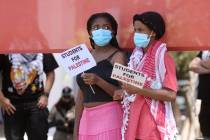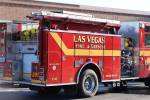Las Vegas considers options for emergency medical transports
Las Vegas is poised to make big changes to the way it operates the city Fire Department, a situation that has firefighters, private ambulance employees and politicians angling to be included in the outcome.
On Wednesday, the City Council heard the results of a controversial study by the International City/County Manager's Association that recommended the Fire Department either get out of the business of transporting patients to the hospital or take over the process it now shares with private ambulance company AMR.
It was one of 23 recommendations . The council voted 6-0 to accept the report.
The study comes as the city tries to rein in a Fire Department budget that grew from $77 million in 2004 to $111 million this year, a 44 percent increase city officials say is unsustainable.
"We still do have a structural deficit," City Manager Betsy Fretwell said after the presentation. "Our revenue is still not as high as our current expenses and we are using reserves to balance things out."
The role of the Fire Department is important in the broader budget mix because not only has public safety grown from 60 percent to 66 percent of total spending since 2007, some in city government and elsewhere view grabbing a bigger slice of patient transports as a potential way to boost revenue.
The Fire Department handles 28 percent of emergency medical transports with the remaining 72 percent done by private ambulances.
Both city fire and rescue and private ambulances are often dispatched simultaneously . The Fire Department tends to transport patients in the most dire circumstances, like gunshot wounds or cardiac arrest.
In one recommendation presented with the study results, the department would discontinue emergency transport service and allow private ambulance companies to pick up the slack. The study estimates that move could save $14 million to
$18 million a year.
An alternative recommendation is to take over all medical transports from the private ambulances, which the study estimates could generate $12 million to $14 million in revenue from charges to patients.
Las Vegas Fire Chief Mike Myers said the department could handle all transports if it changed its business model to be more flexible with the 21 ambulances and staff it already has.
During the presentation to the council, Myers proposed forming a committee that would include emergency medicine and public safety experts to study the issue and deliver a recommendation to the council within nine months.
"We are designing a brand new EMS delivery system for the city of Las Vegas," Myers said.
Scott Johnson, newly elected president of the International Association of Firefighters Local 1285, said the union supports taking over more transports from AMR. The union originally opposed the $155,000 study but has shifted its focus to highlighting why firefighters think it would be beneficial for them to take on more transports.
"If you are trapped in a vehicle, they can get you out. If you are in a burning building, they can get you out," Johnson said of firefighter paramedics who are trained in rescue techniques. "That is the type of responder that any community wants, somebody who can take action in any emergency."
Johnson also disputed the city's characterization of the Fire Department budget as unsustainable.
In 2008, department spending was $108 million, he said, and this year is expected to be about $109 million.
During that same time, Fire Department revenue from patient transports increased from $2.7 million to $6 million, he said.
"If you were in a business model, this would appear good," Johnson said.
But AMR General Manager Mike Gormansaid the current system of dual response by public and private agencies is a gold standard for community safety.
"From our standpoint, yes, the EMS performs extremely well," he said.
In the past, Gorman has warned it isn't as easy as it may appear for public agencies to raise revenue in the patient transport business, given they tend to have higher fixed costs than private companies.
Gorman has said AMR needs to average about $350 per transport to make a profit, which sounds easy given the approximately $1,000 it can charge for an insured patient.
But about 30 percent of the company's trips don't result in a transport. Another 30 percent or so don't have insurance. About 10 percent are paid for by Medicaid at a rate of $180.
The company has about 90 ambulances stationed throughout the valley, plus another 30 percent in reserve for maintenance, Gorman said.
City Council members sought to make sure they were going to have a say. Councilwoman Lois Tarkanian bristled at Myers' suggestion that the upcoming committee remain free of council members to avoid political influence.
"I wanted to ask if we could come to the committee meetings and just sit; I can't see what the problem would be," Tarkanian said.
Councilman Ricki Barlow said omitting council members wouldn't take politics out of play.
"Everyone at the table has political interest," he said. "At the end of the day, chief, it is we the seven who will be voting this up or down. I want to make sure I have the opportunity to participate as much as possible."
Contact reporter Benjamin Spillman at bspillman@ reviewjournal.com or 702-383-0285 .
Final Report - Fire and Emergency Medical Services























